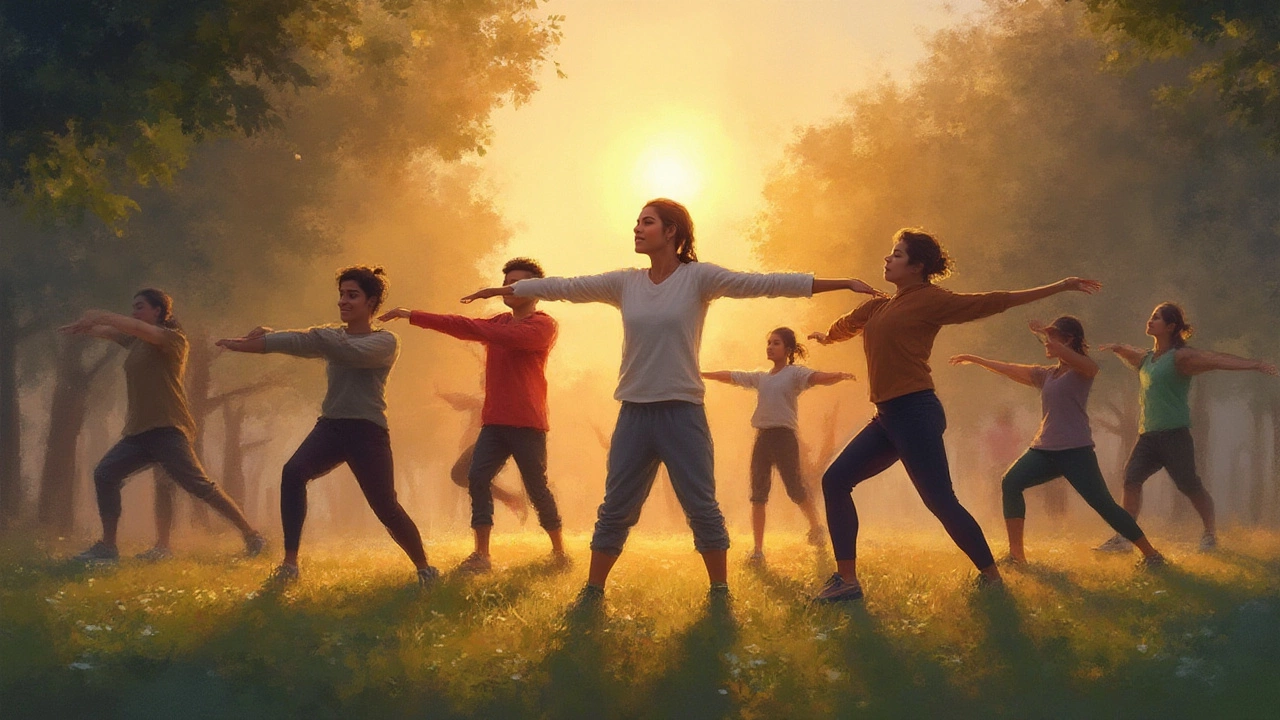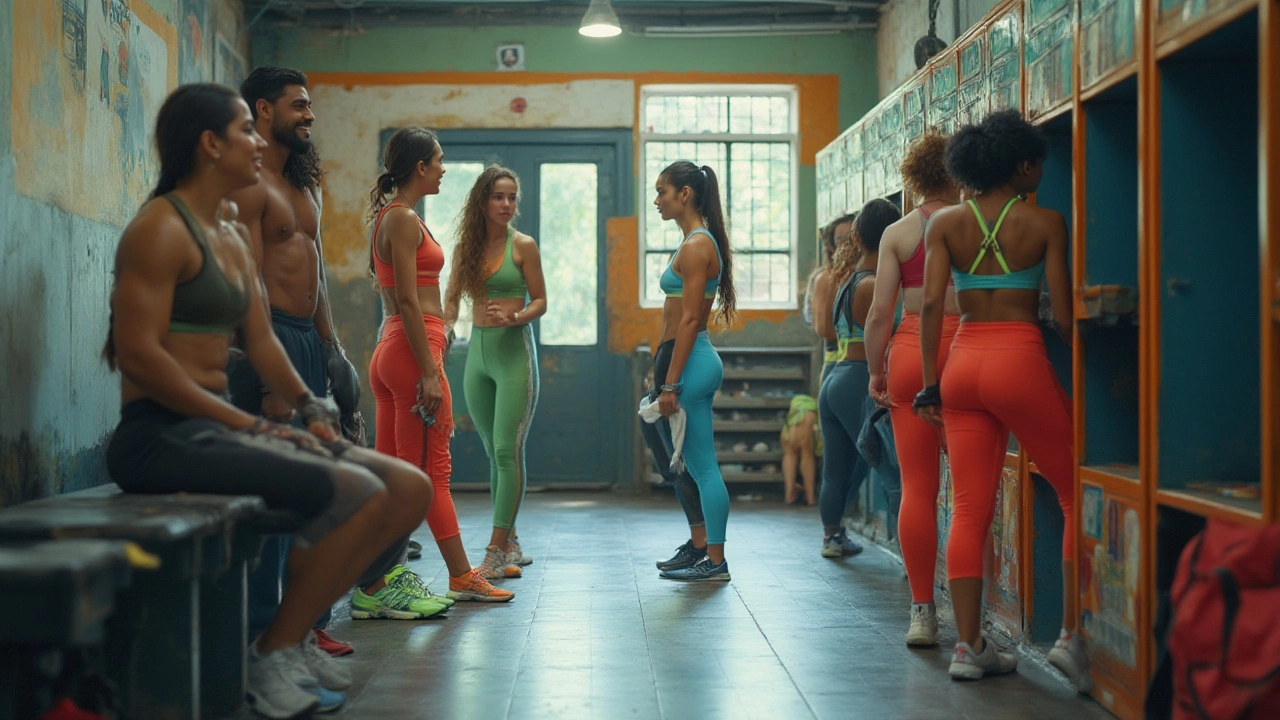Is it gym wear, activewear, sportswear, or something else? If you've ever stared blankly at a store section labeled 'Fitness Apparel' and wondered how all these words differ, you're not alone. The language of gym clothes has exploded in the last decade. In my house, I've heard everything—from 'comfies' to 'sweat kit'—thanks to my wife, Fiona, and her yoga group. But there are genuine labels that'll help you shop smarter, sound sharper, and even keep your gear fresh longer. Let's break down what these words mean, why they matter, and how gym wear went from bland to a bold fashion statement.
The Many Names of Gym Wear
The phrase gym wear seems basic, but what’s really going on here? Gym wear covers clothes you put on for exercise—think tank tops, leggings, shorts, tees, and that favorite hoodie you claim is for 'recovery.' If you see 'workout clothes,' 'fitness apparel,' 'activewear,' or 'athletic clothing,' you’re looking at similar categories. Here’s where it gets interesting: brands have spent billions branding these as more special than they sound. Adidas and Nike popularized 'sportswear' in the 1990s and 2000s, and suddenly it wasn’t just for the gym—it was street style, brunch gear, even office casual in creative workplaces.
'Activewear' boomed after big names like Lululemon and Under Armour started touting super-fabric yoga pants and breathable tees. Technically, 'athleisure' (a blend of 'athletic' and 'leisure') describes gym wear you could wear to meet friends for coffee or run errands. Sportswear is broader: it can cover uniforms for soccer, tennis dresses, or even ski jackets—anything linked to a sport or activity. 'Performance wear' and 'training wear' are more niche, often aimed at people who care about sweat-wicking, anti-odor fabrics, or muscle compression.
Some gyms and studios even customize the terms just for their clientele. Spin class boutiques will sell 'cycling kits,' while CrossFit boxes push 'training gear.' Not to mention the lingo explosion that came with TikTok and Instagram—#fitfam, #gymfit, and more. It’s not just branding, it’s culture. If you care about sustainable fashion, you might spot 'eco-activewear' or 'green gym wear' in trendy shops. Knowing which term is used helps you navigate stores, websites, and even conversations in fitness circles without missing a beat.
Sometimes, people use these terms interchangeably, which adds to the confusion. But essentially, they're all pointing toward the same thing: clothes designed for movement. Search for 'athletic clothing' on Google, and you’ll find everything from compression shorts to tennis skirts. It doesn’t matter if you’re a runner, a weightlifter, or someone who occasionally attempts stretching—these labels all have you covered.
How Gym Wear Became Everyday Fashion
Once, gym wear was strictly functional and stayed hidden in gym bags unless you were working out. Fast-forward to 2025, almost everyone has at least one pair of leggings they've worn outside the gym. Plenty of folks (guilty as charged) rock track pants for errands, airport travel, or just lounging around the house. This shift didn’t happen by accident. Back in the early 2000s, celebrities and athletes turned up at shopping malls and movie premieres in tracksuits, pairing them with designer shoes. Brands caught wind fast—think Puma, with Rihanna’s Fenty line, or Adidas collaborating with Kanye West. Suddenly, comfort became the gold standard, and gym wear got a serious style upgrade.
The growth of athleisure was bananas. According to a 2023 global report, athleisure sales hit over $500 billion. The pandemic turbocharged this trend—even meetings moved online, so stylish, comfy pants topped the must-have list. Hoodies and joggers became status symbols, not just lazy-day wear, and folks invested in high-end performance shirts, even if their idea of cardio was just briskly walking the dog. Getting the right language helped too. No one wants to admit they're in 'sweatpants' all day, so 'activewear' made it classy and purposeful. If you say you’re 'in workout clothes,' it sounds like you’re prepped for action, or at least thinking about it.
Major brands now design lines meant to be seen outside the gym. Double-duty clothes—think sweat-resistant tees that also look sharp with jeans—are everywhere. And the science behind fabrics is a huge draw: compression leggings for better blood flow, tees that resist odors, and eco-friendly yoga wear. For shoppers, learning the lingo means you don’t get stuck with clothes that won’t hold up at the gym, or worse, stuff that’s comfy in class but falls apart in the wash. Today, gym wear has a passport for virtually any occasion—and the right words can get you there in style.

The Science and Style Behind Gym Wear Choices
It's not just about looking good (though that's definitely part of it). Smart gym wear uses cutting-edge fabrics and construction techniques, and knowing a bit about these can save you money, sweat, and hassle. Beginners often reach for 100% cotton tees for workouts, but cotton traps moisture and stays soggy, leading to discomfort and even skin irritation. Synthetic fibers like polyester, nylon, or blends with spandex (aka Lycra) wick sweat away from your skin and dry in a flash. This makes a massive difference during high-intensity workouts or long-distance runs.
Another tip: fit is everything. Gym wear should be snug enough to move with you but not so tight it restricts breathing or movement. Ever try a hot yoga class in loose shorts? Lesson learned—those downward dogs get dangerous pretty fast. Compression wear, which first showed up in pro athletics to aid muscle recovery, is now common and helps many gym-goers feel more supported during lifting or HIIT classes. And don’t overlook ventilation panels. A mesh panel at the back or under the arms makes a humid gym feel way less suffocating.
Antimicrobial fabrics have become a game-changer for anyone who hates that post-workout funk. Some brands bake silver ions into their fibers, which keep bacteria (and odor) at bay. If you’re splurging on gym wear, check the labels for these little extras—they can mean the difference between donating a t-shirt after a few months and wearing it for years. Color choices matter too. Blacks and grays hide sweat stains, while fun prints—like neon camo or graphic stripes—add some personality. Fiona swears by bright leggings for her Zumba class; she claims they give her more energy (psychology? Maybe. Fun? Definitely).
So, how do you pick the best set? Think about what activity you’re doing. Runners might need lightweight, seamless shorts; yogis prefer high-stretch leggings with a wide waistband. Climbers love tops with reinforced stitching. Always try the 'bend and squat' test in new gear before buying—if it goes see-through, leave it on the rack! While it’s tempting to buy cheaper, bulk options, investing in one or two high-quality pieces saves money in the long run—they last longer, perform better, and just feel good.
Tips for Buying and Caring for Your Gym Wear
Shopping for gym wear can feel like a maze, especially with the flood of online choices and influencer recommendations. Start by figuring out how much gear you actually need. For someone who works out 3–5 times a week, a solid kit includes: two to three tops, two bottoms, one supportive sports bra if needed, good socks, and a fitted jacket or hoodie for cold days. If you sweat buckets (like me), you’ll want backup shirts. When you’re shopping, look for reinforced seams and flatlock stitching—this stops uncomfortable chafing during movement.
- Always try before you buy if you can. Jump, stretch, and twist in the change room. Does it pinch, roll, or ride up? Hard pass.
- Check reviews—real people mention if items shrink, fade, or lose stretch quickly.
- If you buy online, scan the brand’s return policy. Some brands, like Lululemon, have 'Love It or Return It' windows for workout gear.
- Check for care labels. Most gym wear is best washed cold, inside out, and air dried to keep elasticity strong and odors low.
- Skip fabric softener. It ruins performance fibers. Instead, try a sports detergent designed to dig out sweat and bacteria.
Storage is huge—don’t shove damp gym wear in a gym bag for hours; it breeds mildew and makes clothes stink. Get in the habit of tossing clothes straight in the wash when you get home. For high-end pieces with built-in tech (like those antimicrobial fibers), store them away from direct sunlight and heat to keep them working longer. Every few months, give your gear a deep clean with a vinegar rinse to blast out hidden buildup.
If you care about the planet, look into sustainable gym wear options. Plenty of new brands use recycled plastics or bamboo that’s been processed into soft, breathable fibers. Old shoes and gear can be recycled at select stores—Nike, for example, shreds worn sneakers for playgrounds and sports courts. Not every brand is perfect, but a growing number do care about their environmental footprint.
Finally, have fun with it. Gym wear today is both a science and a statement. Mix up colors, go bold with patterns, and don’t feel tied to traditional looks. My own favorite shirt is a wild orange tank I bought after seeing it on a marathoner’s Instagram—does it make me faster? Probably not. Do I feel like a superhero? Every single time. At the end of the day, whatever name you give it—gym wear, activewear, or just 'my go-to gear'—it’s about moving comfortably and confidently, wherever the day takes you.
